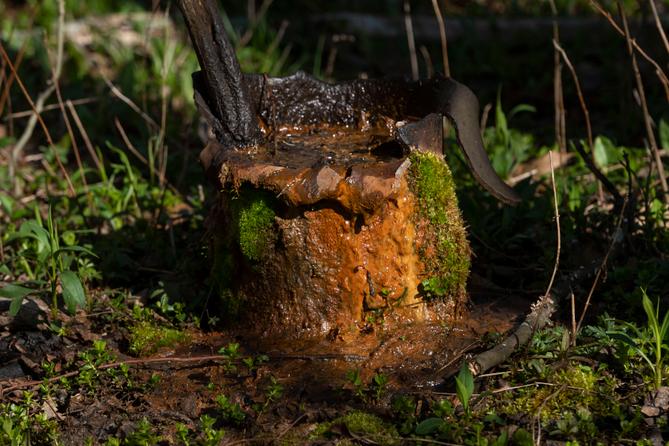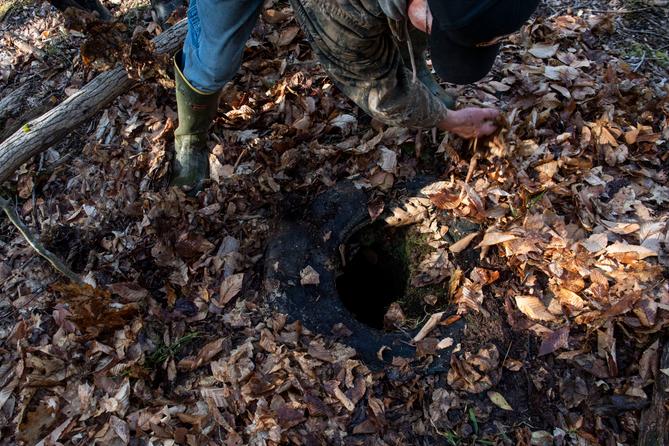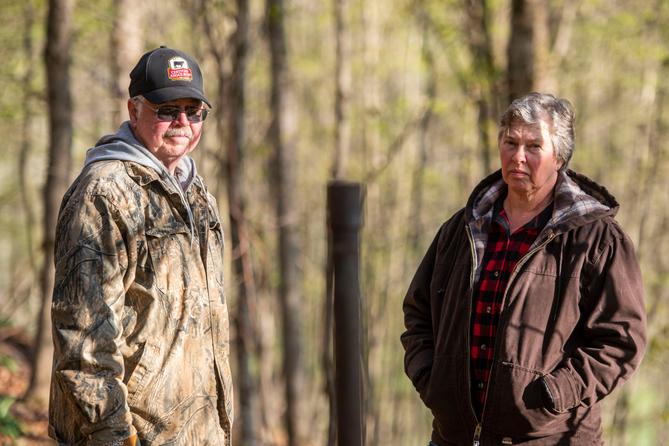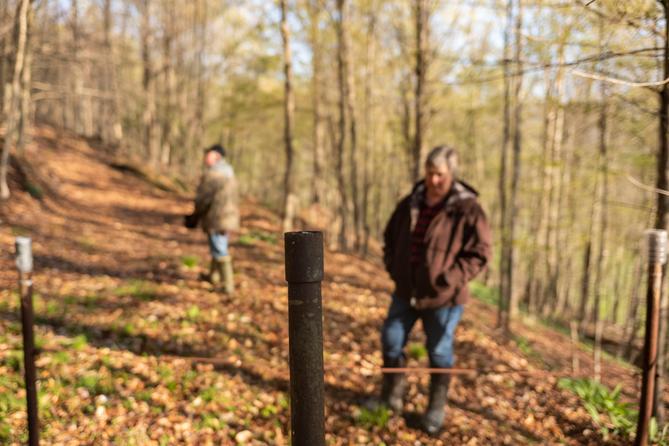Spotlight PA is an independent, nonpartisan newsroom powered by The Philadelphia Inquirer in partnership with PennLive/The Patriot-News, TribLIVE/Pittsburgh Tribune-Review, and WITF Public Media. Sign up for our free newsletters.
HARRISBURG — Cheryl Thomas first asked Pennsylvania officials to cap old oil wells on her land in 1988.
Abandoned by the companies that drilled them, some of the wells on her McKean County property leak fluid, methane, or both. Others, Thomas said, are so big that an adult could fall into them.
But her pleas for help have mostly gone unheard, she said. Decades later, almost half of the 62 wells on her property remain open, forcing her to live alongside leaky and dangerous relics of Pennsylvania’s long history of resource extraction.
An expected infusion of federal money, and a commitment from Democratic Gov. Josh Shapiro to prioritize the issue, have given some lawmakers and environmental advocates hope that the state will be able to do more to plug thousands of abandoned gas and oil wells.
But some also acknowledge that the problem can’t be solved with money alone.
Hundreds of thousands of oil and gas wells have been drilled in Pennsylvania since the oil rush began more than 100 years ago.
If a well has been inactive for at least a year, the state declares it abandoned and requires the operator or owner to plug it. Doing so is key to preventing contamination of soil and water as well as the release of methane, a greenhouse gas that is more than 25 times more potent at trapping heat in the atmosphere than carbon dioxide.
State officials estimate there are roughly 200,000 abandoned wells in Pennsylvania, though an analysis of methane emissions found the number could be as high as 750,000.
A recent report from the Pennsylvania Department of Environmental Protection found well operators routinely fail to plug wells as required.
The agency also plugs wells, but only if it cannot identify who owns it, if it was drilled before 1984, or as a last resort. Otherwise, it seeks to compel the owner of the well to take care of the plugging.
The latter has proved challenging for the department, which said in a recent report there is a “culture of non-compliance” among well operators.
Stuck in the middle are people like Thomas. During her decades pushing DEP, well owners, and local politicians for a solution, Thomas said she more than once found herself getting frustrated and telling them, “Well, I guess you’re just waiting for us to die.”

The high cost of plugging wells
While abandoned wells pose a range of safety issues, including environmental contamination and sinkholes, their tendency to leak large amounts of methane is one of the state’s biggest concerns.
The 1984 law that regulates Pennsylvania drilling companies made DEP responsible for plugging unproductive wells that were dug before 1985, commonly called orphan wells. DEP also plugs wells when an owner cannot be identified.
As part of the federal 2021 Infrastructure Investment and Jobs Act, Pennsylvania could receive as much as $400 million over the next decade to plug abandoned and orphaned wells. In a speech unveiling his first budget proposal as governor, Shapiro said his administration would apply for the maximum amount of money the state is eligible to receive.
“Let’s plug the wells, improve our air quality, and strengthen our communities,” Shapiro said.
In spending this new federal funding for well-plugging, DEP has said it is prioritizing wells that have a high position on its Abandoned Orphan Well List, which uses an internal scoring system to decide which ones are most in need of plugging. The criteria include the structural integrity of the well, the danger to people and the local environment, and other hazards.
So far, the federal government has given the state an initial $25 million grant, which it has used to plug 20 wells as of May 9. The federal Department of Interior designated the funds to plug 50 wells in total.
Some environmental activists fear the funding won’t be enough to meaningfully address the issue, in part, because of the scope of the problem.
The state has spent $37 million over the past three decades to plug 3,000 abandoned wells — a small fraction of the more than 25,000 DEP has documented during that time and an even smaller fraction of the hundreds of thousands of wells the state is understood to have. DEP says the average cost of plugging a well is $33,000, but can reach as much as $800,000.
The price of plugging just the 25,000 documented wells is projected to be as high as $1.8 billion.
‘A game of whack-a-mole’
Under state law, companies must cap oil and gas wells drilled after 1984 when they become inactive. DEP is charged with enforcing that requirement, but it has struggled to do so.
One issue DEP faces is knowing which wells are no longer productive. Between 2017 and 2021, 57% of well operators failed to submit mandatory production reports to the state, according to a DEP report. During that same time period, the agency issued 3,123 citations for failure to plug a well once it was abandoned.
“It’s like a game of whack-a-mole,” said state Rep. Greg Vitali (D., Delaware), chair of his chamber’s environmental committee. “It’s great getting federal money to plug these things. But if you’re plugging old [wells] as new ones are getting abandoned, then you’re not doing anything.”

Arthur Stewart, president of Cameron Energy Company and a member of the state’s advisory council on crude oil development, said that he has not seen this “culture of non-compliance” in the industry that the DEP alleged in the report.
Stewart also heads the PA Grade Crude Oil Coalition, a lobbying group that represents well owners and operators. He said he emailed his board after the DEP report was released to ask if there were cases of noncompliance among board members and they replied no. The coalition members are responsible for tens of thousands of wells, according to Stewart.
He also said that DEP stopped accepting paper copies of production and mechanical inspection reports, which he argues prevents smaller producers — those that own 10 or fewer wells — from being able to turn in reports on time.
In its report, DEP said it has the “necessary authority and tools” to regulate oil and gas companies, such as denying them permits, placing liens against their properties, and even issuing criminal referrals. What it doesn’t have, the report found, is enough money to hire field inspectors, legal counsel to focus on compliance, and permitting administrators to enforce the rules.
The federal money will make a difference on that front. DEP is currently hiring 41 new staffers for the Office of Oil and Gas Management. The positions will be funded by the initial $25 million grant, which allows 10% of the money to go toward administrative costs.
Dave Palmerton, who owned a consulting business that plugged wells in Pennsylvania and is now a director at environmental consulting firm SCS Engineers, told Spotlight PA that DEP primarily needs more administrative resources.
“There are probably many gas wells that get reported as still in operation which are in fact not in operation,” Palmerton said. “This may be because either they are not telling the truth or because it’s producing such a small amount of gas that it’s being left on so that it’s not necessary to plug the well.”
Katie Blume, the policy and legislative director of Conservation Voters of PA, also said that funding issues affect DEP’s enforcement.
“DEP has been historically underfunded and needs to ramp up a lot of funding for staff in particular,” she said.
In theory, DEP can recoup costs for well plugging through the bonds it requires operators to put up before they drill.
If an operator abandons a well and fails to meet their legal obligations, the bond should offset the cost of plugging the well.
But the cost of these bonds is much lower than the cost of plugging a well, and DEP has said it rarely pursues forfeiture for that reason. Bonds for conventional wells are capped at $2,500 but DEP says that the average cost of plugging a well is over 10 times that amount.
A bill passed by the legislature in 2022, and that former Democratic Gov. Tom Wolf allowed to become law without his signature, capped the bond costs and took away an independent regulatory board’s ability to raise the cost.In a regulatory atmosphere like this, Karen Feridun of the environmental group Better Path Coalition argued that DEP can’t meaningfully promise to hold drillers accountable.
“Stop overpromising what you can handle when you demonstratively can’t handle any of it,” she said of DEP. “They have failed on managing the compliance piece of it, failed on getting the industry to report what it’s doing.”

Thomas, the property owner who has been trying to get her wells plugged since the 1980s, said she’s so exhausted from her dealings with DEP that she plans to abandon her efforts — at least for the time being.
“It took 25 years to get any action,” Thomas said. “Does that tell you anything?”
WHILE YOU’RE HERE… If you learned something from this story, pay it forward and become a member of Spotlight PA so someone else can in the future at spotlightpa.org/donate. Spotlight PA is funded by foundations and readers like you who are committed to accountability journalism that gets results.
